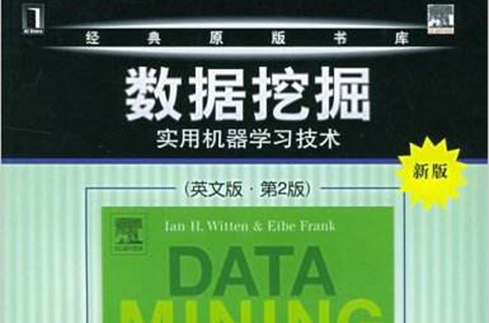《經典原版書庫·數據挖掘:實用機器學習技術》一書的出版社是機械工業出版社,出版時間是2005年9月1日。
基本介紹
- 書名:經典原版書庫·數據挖掘:實用機器學習技術
- ISBN:9787111172482
- 頁數:524頁
- 出版社:機械工業出版社
- 出版時間:2005年9月1日
- 開本:16開
圖書信息,作者簡介,內容簡介,媒體評論,目錄,
圖書信息
出版社: 機械工業出版社; 第1版 (2005年9月1日)
叢書名: 經典原版書庫
平裝: 524頁
開本: 16開
ISBN: 7111172485
條形碼: 9787111172482
尺寸: 23.8 x 18.4 x 2.2 cm
重量: 762 g
作者簡介
作者:(紐西蘭)威滕
Lan H.Witten紐西蘭懷卡托大學計算機科學系教授,ACM和紐西蘭皇家學會成員。他曾榮獲2004年國際信息處理研究聯合會頒發的Namur獎項,這是一個兩年一度的榮譽獎項,用於獎勵那些在信息和通信技術的社會套用方面做出傑現貢獻及具有國際影響的人。他的著作包括《Managing Gigabytes》(1999)、《How to Build a Digital Library》(2003),以及眾多的期刊文章和會議論文。 Eibe Frank,紐西蘭懷卡托大學計算機科學系高級講師。他在機器學習領域發表了大量的論文,是《Machine Learing Journal》和《Journal of Artificial Intelligence Research》的編委之一。 同時他還是許多數據挖掘和機器學習學術會議設計委員會的成員。作為Weka機器學習軟體的核心開發成員之一,他維護並不斷完善著這個軟體。
內容簡介
本書對1999年的初版做了重大的改動。雖說核心概念沒有變化,但本書進行了更新使其能反映過去5年裡的變化,參考文獻幾乎翻了一番。新版的重要部分包括:30個新的技術章節;一個加強了的具有互動式界面的Weka機器學習工作平台;有關神經網路的完整信息,一個有關貝葉斯網路的新節;等等。
本書提供了機器學習概念的完整基礎,此外還針對實際工作中套用相關工具和技術提出了一些建議,在本書中你將發現:
●成功數據挖掘技術的核心算法,包括歷經考驗的真實技術及前沿的方法。
●轉換輸入或輸出以改善性能的方法。
●可下載的Weka軟體??一個用於數據挖掘任務的機器學習算法的集合,包括用於數據預處理、分類、回歸、聚類、關聯規則以及在新的互動式界面上可視化的工具。
媒體評論
書評
“本書將這門新的學科用一種非常容易理解的方式呈現給讀者:它既是一本用於培訓新一代實踐者和研究工作者的教科書,同時對於我這樣需要不斷充電的專業讀者也極具啟示作用。Witten和Frank熱切追求的是簡單而流暢的解決方案,他們時刻不忘將所有的概念都建立在具體實例的基礎之上,促使讀者首先考慮簡單的技術,如果這些簡單技術不足以解決問題,再進一步考慮更為高級和成熟的技術。
假如你想分析和理解數據,本書以及相關的Weka工具包將非常有用。”
――摘自微軟研究院圖靈獎得主Jim Gray所做的前言
目錄
Foreword
Preface
Part I Machine learning tools and techniques
1. What?s it all about?
1.1 Data mining and machine learning
1.2 Simple examples: the weather problem and others
1.3 Fielded applications
1.4 Machine learning and statistics
1.5 Generalization as search
1.6 Data mining and ethics
1.7 Further reading
2. Input: Concepts, instances, attributes
2.1 What?s a concept?
2.2 What?s in an example?
2.3 What?s in an attribute?
2.4 Preparing the input
2.5 Further reading
3. Output: Knowledge representation
3.1 Decision tables
3.2 Decision trees
3.3 Classification rules
3.4 Association rules
3.5 Rules with exceptions
3.6 Rules involving relations
3.7 Trees for numeric prediction
3.8 Instance-based representation
3.9 Clusters
3.10 Further reading
4. Algorithms: The basic methods
4.1 Inferring rudimentary rules
4.2 Statistical modeling
4.3 Divide-and-conquer: constructing decision trees
4.4 Covering algorithms: constructing rules
4.5 Mining association rules
4.6 Linear models
4.7 Instance-based learning
4.8 Clustering
4.9 Further reading
5. Credibility: Evaluating what?s been learned
5.1 Training and testing
5.2 Predicting performance
5.3 Cross-validation
5.4 Other estimates
5.5 Comparing data mining schemes
5.6 Predicting probabilities
5.7 Counting the cost
5.8 Evaluating numeric prediction
5.9 The minimum description length principle
5.10 Applying MDL to clustering
5.11 Further reading
6. Implementations: Real machine learning schemes
6.1 Decision trees
6.2 Classification rules
6.3 Extending linear models
6.4 Instance-based learning
6.5 Numeric prediction
6.6 Clustering
6.7 Bayesian networks
7. Transformations: Engineering the input and output
7.1 Attribute selection
7.2 Discretizing numeric attributes
7.3 Some useful transformations
7.4 Automatic data cleansing
7.5 Combining multiple models
7.6 Using unlabeled data
7.7 Further reading
8. Moving on: Extensions and applications
8.1 Learning from massive datasets
8.2 Incorporating domain knowledge
8.3 Text and Web mining
8.4 Adversarial situations
8.5 Ubiquitous data mining
8.6 Further reading
Part II: The Weka machine learning workbench
9. Introduction to Weka
9.1 What?s in Weka?
9.2 How do you use it?
9.3 What else can you do?
9.4 How do you get it?
10. The Explorer
10.1 Getting started
10.2 Exploring the Explorer
10.3 Filtering algorithms
10.4 Learning algorithms
10.5 Meta-learning algorithms
10.6 Clustering algorithms
10.7 Association-rule learners
10.8 Attribute selection
11. The Knowledge Flow interface
11.1 Getting started
11.2 Knowledge Flow components
11.3 Configuring and connecting the components
11.4 Incremental learning
12. The Experimenter
12.1 Getting started
12.2 Simple setup
12.3 Advanced setup
12.4 The Analyze panel
12.5 Distributing processing over several machines
13. The command-line interface
13.1 Getting started
13.2 The structure of Weka
13.3 Command-line options
14. Embedded machine learning
……
15. Writing new learning schemes
References
Index

